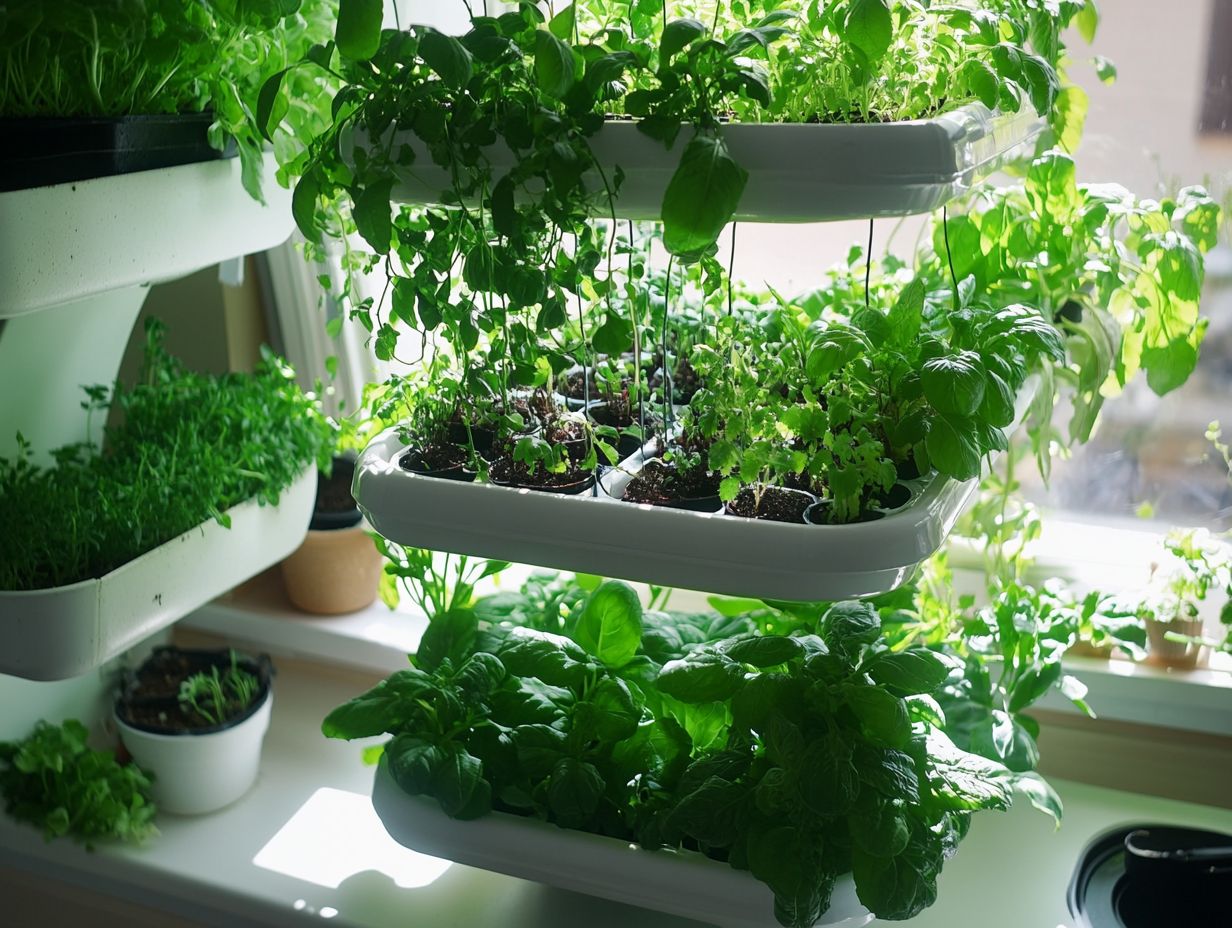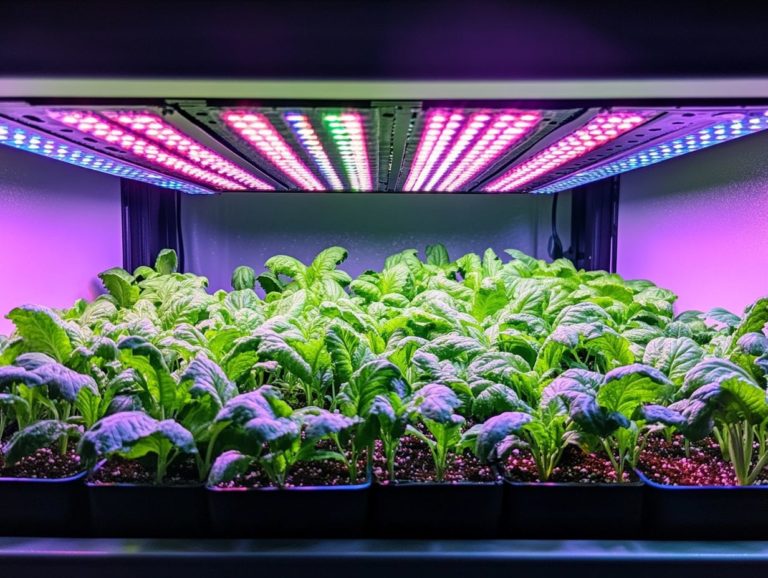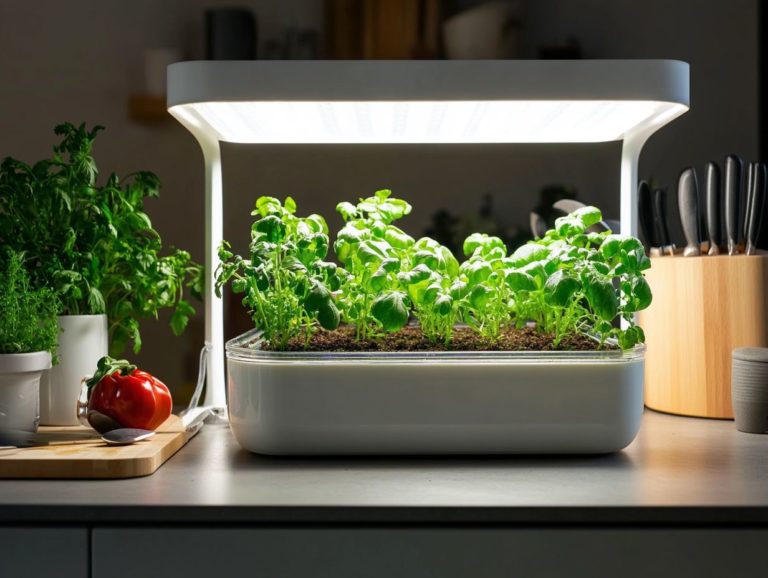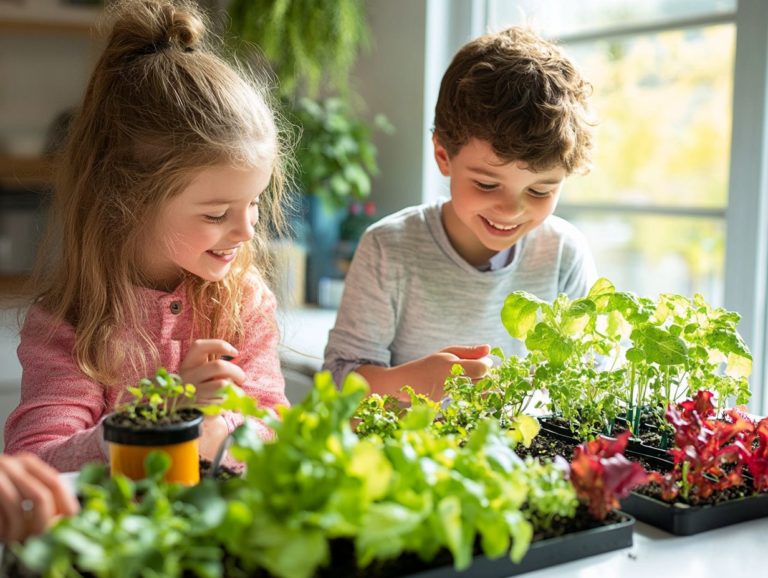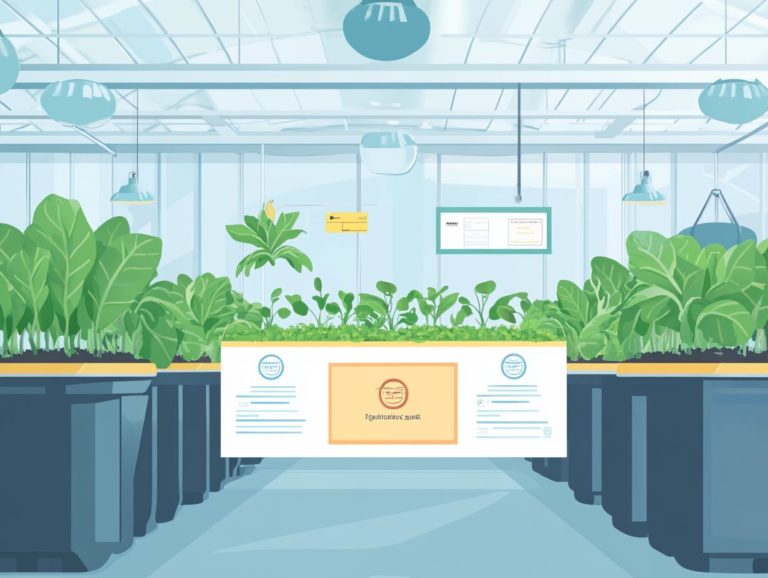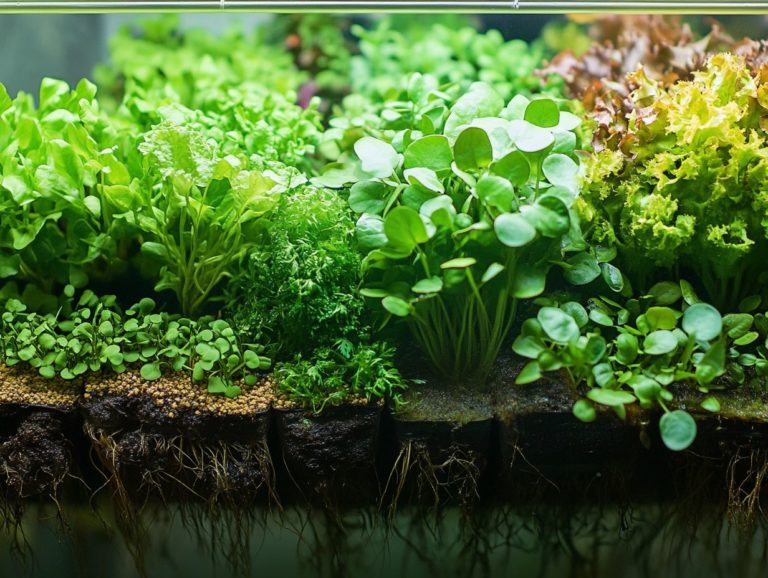How to Scale Up Your Hydroponic Garden?
Hydroponic gardening has revolutionized the way you cultivate plants, enabling efficient growth without the need for soil. If you re already reaping the rewards of a small-scale setup, you may be contemplating an expansion of your garden.
This guide will illuminate the advantages of scaling up your hydroponic space, such as enhanced production and a minimized environmental impact. It will also delve into essential considerations and practical steps to ensure a successful transition.
Are you prepared to elevate your hydroponic gardening experience to new heights?
Contents
- Key Takeaways:
- Benefits of Scaling Up Your Hydroponic Garden
- Factors to Consider Before Scaling Up
- Steps to Scaling Up Your Hydroponic Garden
- Key Tips for Scaling Your Hydroponic Garden
- Frequently Asked Questions
- What is hydroponic gardening?
- Why should I consider scaling up my hydroponic garden?
- How can I determine if my hydroponic garden is ready to be scaled up?
- What are some techniques for scaling up a hydroponic garden?
- What are some common challenges when scaling up a hydroponic garden?
- What should you consider when scaling up a hydroponic garden?
Key Takeaways:
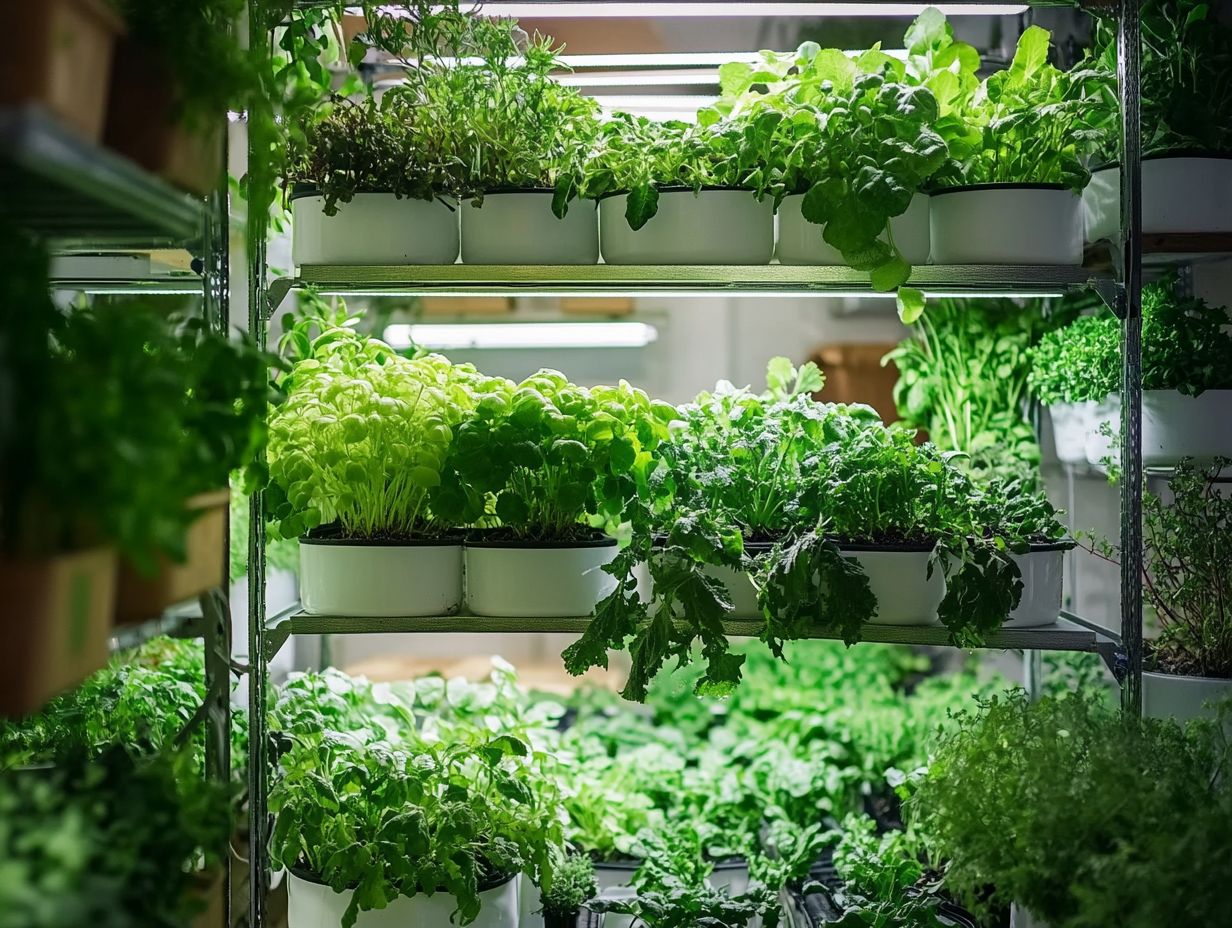
- Plan and prepare before scaling up your hydroponic garden to ensure efficient production and minimal environmental impact.
- Consider factors such as available space, resources, and type of system when deciding on the scale of your hydroponic garden.
- To successfully scale up, assess your current setup, choose the right system, prepare and expand your space, and maintain and troubleshoot regularly.
What is Hydroponic Gardening?
Hydroponic gardening is a groundbreaking approach that allows you to grow plants without soil, harnessing nutrient-rich water solutions to foster robust plant growth. This technique gives you the power to cultivate a variety of crops, from aromatic herbs to fresh vegetables, all within controlled environments, whether indoors or outdoors.
By utilizing hydroponic systems like Deep Water Culture, which is a type of hydroponic system where plants grow in water that is rich in oxygen and nutrients, you can dramatically improve growth rates and yields. These systems are designed for efficient use of resources, allowing your plants to absorb nutrients directly, free from the competition that soil typically presents.
For indoor gardens, a suitable artificial light source becomes essential, providing the necessary intensity and spectrum to optimize photosynthesis. Creating a balanced nutrient solution is crucial for plant health, delivering the essential minerals that your plants need to thrive.
Regular monitoring and care such as adjusting pH levels (which refer to how acidic or basic the water is, affecting nutrient availability) and light cycles further enhance the success and sustainability of your hydroponic gardening efforts, establishing it as a compelling choice for the modern cultivator.
Benefits of Scaling Up Your Hydroponic Garden
Scaling up your hydroponic garden presents a wealth of benefits, including a remarkable boost in crop yield and enhanced efficiency throughout the growing process. By expanding your hydroponic systems, you can optimize resource utilization, resulting in healthier plants and maximized yields.
This approach also gives you the power to cultivate seasonal crops and grow vegetables year-round, regardless of outdoor conditions. In doing so, you embrace a sustainable solution for food production that stands the test of time.
Increased Production and Efficiency
Increasing production and efficiency in hydroponic gardening requires you to optimize your hydroponic systems for enhanced crop measurement and plant growth. By selecting the right plant nutrients and managing water levels effectively, you can achieve remarkable improvements in your overall output.
Utilizing grow lights and effective pruning techniques ensures your plants receive the necessary support for robust root development and access to nutrient-rich water, resulting in high-yield crops. Implementing a routine for monitoring pH levels and nutrient concentrations can significantly enhance uptake and create optimal growth conditions.
Research suggests that maintaining a pH range of 5.5 to 6.5 is crucial for maximizing nutrient availability. Ensuring that light penetrates all parts of your plants is essential for effective photosynthesis, which drives vigorous growth. Utilizing reflective surfaces in your growing area can significantly improve light efficiency.
By adopting these techniques, you may find yourself reaping rewards of up to a 30% increase in yields, especially by utilizing effective tools like an air pump for optimal root development.
Reduced Environmental Impact
Utilizing hydroponic systems enables you to significantly reduce your environmental impact while promoting sustainable agricultural practices that conserve water and minimize nutrient runoff. This groundbreaking farming method gives you control right now! By ensuring that water and nutrients are used efficiently, you can enjoy healthier plants and less strain on natural resources.
Hydroponic gardening thrives in urban settings, further reducing your ecological footprint. With hydroponic systems requiring less space than traditional farming methods, you can transform rooftops and utilize underutilized buildings, making it a practical solution for densely populated areas. This maximizes crop yield, alleviates land competition, and fosters local food production, cutting down on transportation emissions linked to food distribution.
The ability to grow food in controlled environments means you can enjoy fresh produce year-round, tackling the challenge of food deserts that affect many urban communities. In these ways, hydroponics not only represents a significant advancement but also paves the way toward a more sustainable and equitable food system.
Factors to Consider Before Scaling Up

Before you scale up your hydroponic garden, it’s vital to assess key factors like available space and resources. These elements significantly influence the feasibility of expanding your hydroponic systems.
By gaining a clear understanding of your current setup’s limitations such as plant support structures, lighting sources, and nutrient solutions you’ll be better positioned to ensure successful growth and maximize yields.
Available Space and Resources
Assessing the available space and resources is crucial when planning to expand your hydroponic systems. This directly influences the types of crops you can grow and the methods you can implement. Whether cultivating indoors or outdoors, opting for a compact system can help you maximize limited space while ensuring that your plants have enough room for robust root development and healthy growth.
Understanding your environmental conditions like light, temperature, and humidity is essential for optimizing your garden’s performance. Factors such as the amount of sunlight available indoors or the ease of controlling conditions outdoors can significantly impact how you allocate your resources.
It s also vital to consider which growing method best suits your environment. Options include nutrient film technique (a method where a thin film of nutrient solution flows over the roots), deep water culture (where plant roots are suspended in a nutrient-rich solution), and aeroponics (where plants are grown in an air/mist environment without soil). Each method comes with its own space requirements and efficiencies, so making a thoughtful choice can enhance your yields and minimize overhead costs.
Implementing vertical gardening systems and utilizing reflectors can take your productivity to the next level. Investing time in planning your hydroponic setup is well worth your while.
Types of Hydroponic Systems and Best Hydroponic Products
You ll find a variety of hydroponic systems, each boasting its own unique characteristics and advantages. Take Deep Water Culture, for instance. It immerses plant roots in a nutrient solution, promoting robust growth through complete submersion. Grasping these diverse methods is crucial for selecting the hydroponic container that aligns perfectly with your gardening aspirations and available resources.
Among the favored systems, the Nutrient Film Technique (NFT), Ebb and Flow, and Wick systems are particularly noteworthy. Each offers distinct advantages; NFT excels in efficient nutrient delivery and water usage, but its reliance on pump function can jeopardize plant health if something goes wrong. Ebb and Flow systems provide periodic watering, ideal for certain plants, though they may demand a bit more maintenance. Wick systems, with their simplicity, are often a hit with beginners but might struggle to deliver adequate nutrients for larger plants.
Evaluating these factors will empower you to make informed decisions about which system best suits your specific cultivation needs.
Steps to Scaling Up Your Hydroponic Garden
Scaling up your hydroponic garden requires thoughtful and strategic steps. Begin by assessing your current setup to understand its strengths and limitations.
Next, selecting the right system tailored to your specific needs is essential. As you prepare and expand your space, consider factors such as light, airflow, and accessibility.
Finally, maintaining and troubleshooting your system is vital to ensuring optimal plant growth. Every one of these steps plays a critical role in successfully transitioning from a smaller operation to a flourishing, larger-scale hydroponic garden.
Assessing Your Current Setup
Assessing your current setup is the essential first step in scaling up your hydroponic garden. This allows you to pinpoint limitations in crop yield and identify areas ripe for improvement. By evaluating elements like light sources, ways to provide nutrients to plants, and overall plant support, you can gain valuable insights into how effectively your system operates and what adjustments may be necessary for expansion.
To accurately gauge the performance of your existing hydroponic system, it s vital to meticulously document factors like light penetration. Doing so ensures every plant receives the illumination it needs for optimal growth. Measuring nutrient levels and monitoring pH will help you determine crop health, revealing whether any adjustments are necessary for better uptake. Keeping a detailed record of these observations promotes knowledge-based decision-making, empowering you to pinpoint specific issues and test new strategies.
Analyzing growth patterns helps you understand which crops thrive under your current conditions, aiding you in future planning aimed at maximizing yields.
Choosing the Right System for Your Needs
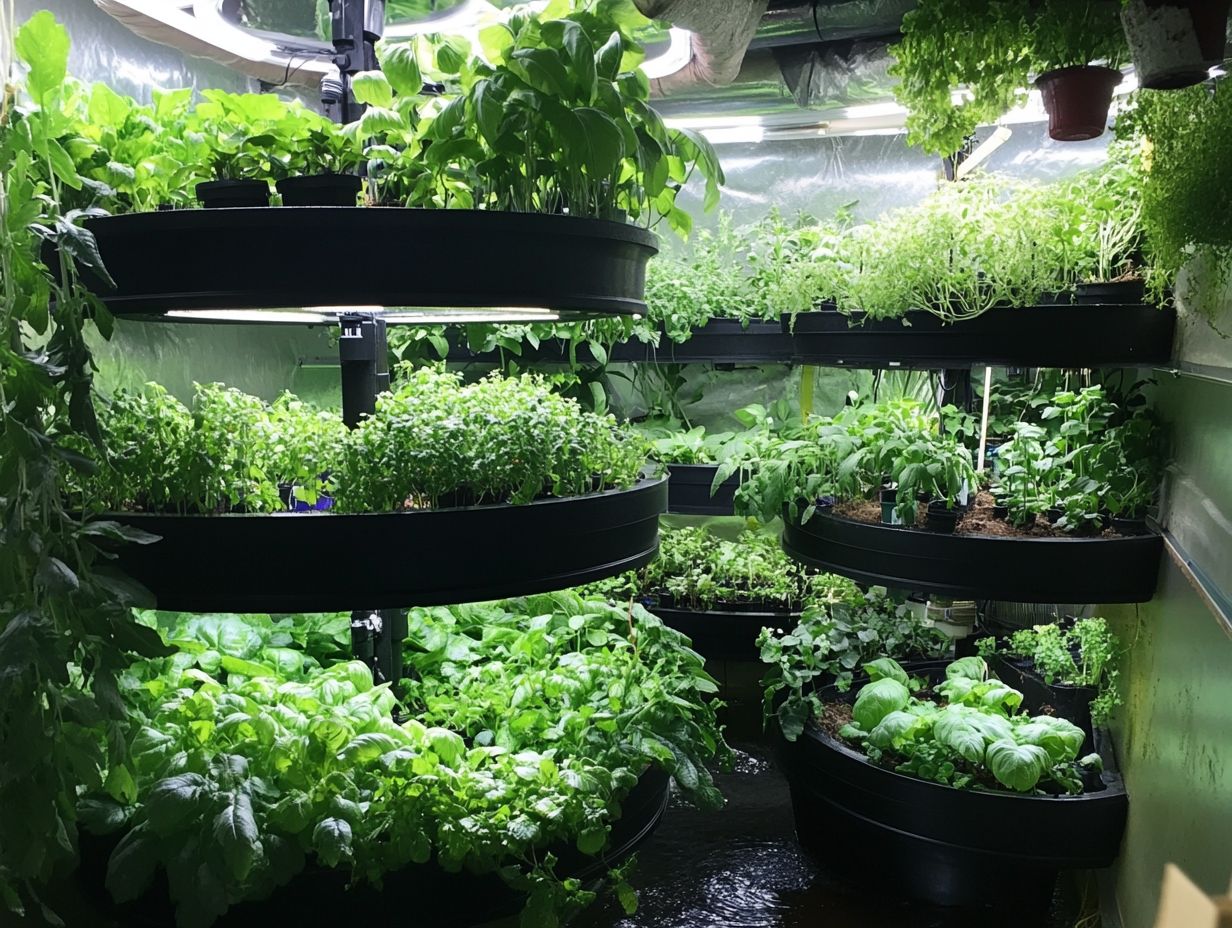
Choosing the right hydroponic system for your needs is essential for achieving gardening success. Options like Deep Water Culture offer unique advantages, particularly in nutrient solution delivery and plant growth. By understanding the specifics of each system, you can steer yourself toward the one that aligns best with your available resources and desired crop yield.
Beyond Deep Water Culture, you might want to explore other systems, such as Nutrient Film Technique and Aeroponics. Each of these presents distinctive features that cater to different gardening ambitions. For example, Nutrient Film Technique is renowned for its efficient nutrient usage, but it requires precise monitoring. Aeroponics maximizes air exposure to promote rapid growth while demanding a bit more technical know-how.
By evaluating your available space—whether it’s a cozy balcony or a more expansive indoor environment—and considering the crops you wish to cultivate, you can make a well-informed decision that not only meets your gardening goals but also enhances the productivity of your setup. If you’re interested in getting started, check out how to start hydroponic gardening at home. Effective nutrient delivery is key, allowing you to fine-tune your approach and ensure the health and vigor of your plants.
Preparing and Expanding Your Space
Preparing and expanding your space for a hydroponic garden requires meticulous planning to meet the specific needs of your growing methods and plant support systems. Whether you’re transitioning to a larger area or optimizing your current setup, thoughtful organization will significantly enhance growth and maximize yield.
Begin by evaluating the layout to ensure that there s ample light exposure, proper ventilation, and easy accessibility. In terms of plant support arrangements, choosing the right structures such as trellises or vertical systems can dramatically increase your use of vertical space while promoting healthy plant development.
You can also boost efficiency through smart resource management. Consider design choices like integrating water recycling systems and optimal nutrient delivery methods. By prioritizing these elements, you can create a highly productive hydroponic environment that flourishes and operates sustainably.
Start your hydroponic journey today and watch your garden flourish!
Act now to ensure your plants thrive!
Maintaining and Troubleshooting Your System
Maintaining and troubleshooting your hydroponic system is essential for achieving optimal plant growth. Regularly monitoring water levels and pH is a critical practice. By identifying potential issues early, you can swiftly address them, ensuring your hydroponic garden remains healthy and productive.
In hydroponics, even the slightest imbalance can have a profound impact on plant health. Regular checks on water levels are vital. They prevent root rot and nutrient deficiencies. Using pH meters ensures that your nutrient solution stays within the ideal range for absorption.
Visual assessments of plant health are crucial. Watch for signs of discoloration, stunted growth, or pest infestations. If problems arise, such as nutrient lockout which means your plants can’t absorb nutrients properly or algae growth, making timely adjustments can create a world of difference. For example, you can monitor water temperature or add helpful microbes to boost plant health.
By establishing these routines, you cultivate a resilient environment that fosters strong and thriving plants.
Key Tips for Scaling Your Hydroponic Garden
The successful scaling of your hydroponic garden hinges on a collection of best practices. These include effective nutrient management and consistent maintenance routines that create optimal conditions for plant growth.
Understanding the intricacies of scaling your operations will influence your efficiency. Ultimately, it can enhance your yields in the art of gardening, especially when utilizing the best hydroponic systems for large scale gardening.
Proper Nutrient Management
Proper nutrient management is crucial in your hydroponic system. It ensures that your plants receive a balanced diet tailored to their specific growth stages. By meticulously formulating nutrient solutions, you can enhance crop yields and promote robust plant development essential when scaling up your operations.
To achieve optimal results, consistently monitor nutrient levels with advanced tools like nutrient meters and pH meters. Understanding how different plants respond to various nutrient concentrations gives you the power to adjust solutions effectively.
Be aware of the evolving nutritional demands during key growth phases. These include seedling, vegetative, and flowering stages. Making precise adjustments fosters healthy growth.
Establish a routine check for nutrient balance. This practice will maximize your productivity and minimize waste, creating a more sustainable hydroponic environment for your plants.
Regular Maintenance and Monitoring
Regular maintenance and monitoring are essential for your hydroponic garden’s success. It’s crucial to keep an eye on systems like air pumps and water levels. Establishing a routine for these tasks ensures your hydroponic system runs smoothly and delivers optimal results.
Your routine should include daily inspections. Verify that the air pumps are working properly, as they play a vital role in oxygenating the nutrient solution. Monitoring water levels prevents plant dehydration and ensures they receive the nourishment they need.
Conduct weekly assessments of plant health. Look for signs of nutrient deficiency or pests. This early detection allows you to address issues swiftly.
By adhering to a well-structured maintenance schedule such as checking pumps each morning and water levels every other day you adopt a proactive approach. This minimizes potential problems while maximizing growth performance.
Frequently Asked Questions
What is hydroponic gardening?
Hydroponic gardening is a method of growing plants without soil. Instead, it uses nutrient-rich water as the main source of nutrition for the plants.
Why should I consider scaling up my hydroponic garden?
Scaling up your hydroponic garden allows for larger and more efficient yields. This can lead to increased profits and a more sustainable growing system.
How can I determine if my hydroponic garden is ready to be scaled up?
You can assess the size of your current garden and evaluate your plant yields. Consider your overall goals for your garden to determine if scaling is appropriate.
Ready to scale up your hydroponic garden? Start implementing these tips today!
What are some techniques for scaling up a hydroponic garden?
You can scale up your hydroponic garden by expanding your space and increasing the number of plants. Using better tools and systems can also help you grow more efficiently.
What are some common challenges when scaling up a hydroponic garden?
Scaling up brings exciting challenges like keeping your nutrient levels just right. You will also need to manage pests and diseases while ensuring proper lighting and ventilation for all your new plants.
What should you consider when scaling up a hydroponic garden?
Consider your budget and make sure you have access to the right resources. You may also need to rethink your garden’s setup and maintenance as it grows.

